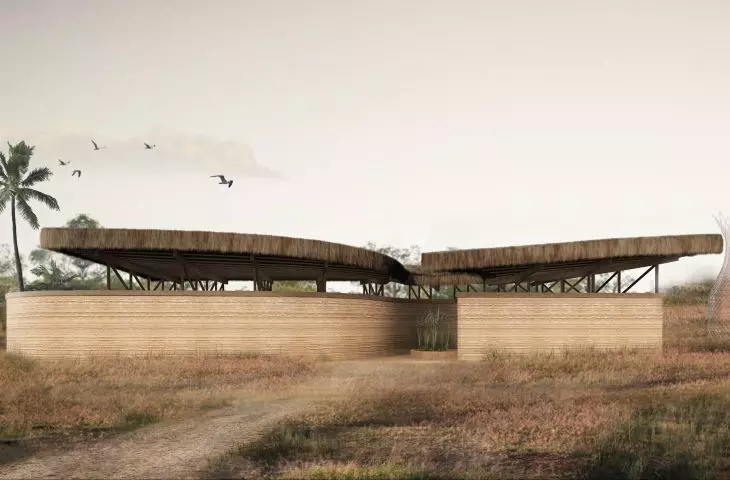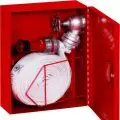Entonnoir is a project for a children's home in Senegal by a team of architecture students from the Wroclaw University of Technology, consisting of: Justyna Matyska, Aleksandra Tarnowska, Paulina Wrąbel and Wiktoria Zarębska. The authors paid special attention to the simplicity of materials and fast construction using Superadobe technology, as well as the shape, which promotes ventilation and water extraction from the atmosphere.
The task of last year's competition was to propose a facility for the village of Baghere in Senegal that would support activities for children at risk of malnutrition by, among other things, providing food, developing programs to raise awareness of hygiene and health care, meeting with pediatricians and social workers. An important point was the provision of overnight accommodation for patients and the training of community nurses. According to the regulations, the one-story building of 250 square meters was to be easy to construct and created from natural or recycled materials.
The building was made with Superadobe technology, and the roof is covered with reeds and bamboo mats
© Justyna Matyska, Aleksandra Tarnowska, Paulina Wrąbel, Wiktoria Zarębska
The competition awarded three Grand Prizes, two Honorable Mentions and five Special Mentions—the results and more information can be found in the competitions section of our portal. Admittedly, the presented project with the French name Entonnoir, meaning funnel, did not make the finals, but the concept deserves attention. The students of the Wroclaw University of Technology, in addition todesigning basic hospitalization rooms and a food storage facility, included education of Baghere residents on how to grow food. Such activities, the students believe, will help prevent worsening malnutrition among children in the village, and the facility itself will be partially independent of external supplies.
Location of the project in Baghere village and direction of winds
© Justyna Matyska, Aleksandra Tarnowska, Paulina Wrąbel, Wiktoria Zarębska
shape taking into account the influence of winds
The shape of the building's body results from the direction of the periodic winds that occur in the Baghere area. The building opens in two directions—to the south (the direction of winds in the rainy season) and northeast (the direction of winds in the dry season). This also divides the building into two distinct zones. The first contains a warehouse directly connected to the administration room and sanitary facilities. The second zone is the hospitalization and recreation space. Due to the changing number of patients in this part, the authors proposed an open, space separated by mobile walls, thanks to which the spaces can be adapted to the current needs of the users. The proposed layout makes it possible to separate three hospitalization rooms, accommodating six beds each.
Entonnoir project, projection
© Justyna Matyska, Aleksandra Tarnowska, Paulina Wrąbel, Wiktoria Zarębska
water-filtering reed
The students designed two courtyards, the first of which is accessible from the front of the building and available to the entire village. This is where food is dispensed. The second courtyard is used for crops. Both are equipped with water reservoirs to support the operation of the building, and water retention is also possible thanks to them. Filtration is provided by reeds influencing the occurrence of phyto-purification.
The growing reed, thanks to its purifying properties and the aerobic bacteria located around its roots, helps treat the water. In the late stages of the plant's growth, the material can be harvested and used for roofing replacement, the authors explain.
In the courtyards there are water reservoirs
© Justyna Matyska, Aleksandra Tarnowska, Paulina Wrąbel, Wiktoria Zarębska
A roof like a funnel and fog catchers
The project's name Entonnoir means funnel in French, and the shape refers to the building's roof, which collects water. During the monsoon season, rainwater flows down the main funnel into a central reservoir, where the filtration process begins. It then travels to a second reservoir, from where it can be drawn to irrigate plants.
Entonnoir project, cross-section and roof like a funnel
© Justyna Matyska, Aleksandra Tarnowska, Paulina Wrąbel, Wiktoria Zarębska
For crops that require more water, the students suggested using CloudFisher collectors, or fog catchers, which are designed to collect atmospheric water vapor. The collectors are covered with a mesh on which the moisture condenses, after which it goes into a container underneath.
Earthbag walls
When choosing materials, an important factor for us was the ecological aspect, the economic aspect and the availability of products in the designed area, the authors say.
Taking these criteria into account, the designers used the simple and fast Superadobe construction technology. It was created by Iranian architect Nader Khalili and involves erecting walls made of long bags filled with earth. Strands of barbed wire are placed between each layer to act as both mortar and reinforcement.
Entonnoir project, inner courtyard
© Justyna Matyska, Aleksandra Tarnowska, Paulina Wrąbel, Wiktoria Zarębska
The roof structure consists of wooden lattice trusses, while the roofing proper was made of reeds and bamboo mats. Specially molded clay forms the floors and wall finishes. All materials used are carbon-neutral, inexpensive and readily available.
design detail
© Justyna Matyska, Aleksandra Tarnowska, Paulina Wrąbel, Wiktoria Zarębska
Read also about the design of a farm and education center in Ghana by Agata Holdenmajer and Jagna Przybylska. The work received Third Prize in the Ghana Innovation Farm competition.






































